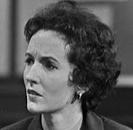Sonia Borg was born in Vienna where she studied dramatic art before moving to India in 1951. While based in India, Borg joined Shakespeareana International, a touring theatre company.
In 1961, she moved to Australia and joined Crawford Productions as a drama coach. She also worked as a script writer, editor and associate producer. She wrote her first scripts for Crawfords as early as 1961, with episodes of Consider Your Verdict. She continued to write for Crawford Productions for the next two decades, with scripts for Homicide (for which she wrote at least seventeen episodes, between 1964 and 1973), Division 4 (1970 to 1975), Matlock Police (for which she wrote at least eleven episodes between 1971 and 1975), and Solo One (1976). She also worked in a production capacity for these programs: as associate producer (1964-1969), producer (1969-1972), and supervising producer (1967) for Homicide; producer (1969) for Division 4; and both assistant producer and associate producer (1964) for Consider Your Verdict. She was also Homicide's script editor between 1968 and 1971.
While working for Crawford Productions, Borg was also writing scripts for other television studios and production companies, including Gemini Productions (The Spoiler, 1972) and the ABC (including an episode of the anthology series A Time for Love in 1972, and at least three scripts for Rush in 1974).
In 1976, she contributed to the ABC and Paradine Productions' Power Without Glory, based on Frank Hardy's book, and written in conjunction with other major Australian script-writers, including Cliff Green, Howard Griffiths, Tom Hegarty, John Martin, and Roger Simpson. The same year, she adapted Colin Thiele's novel into the film Storm Boy, which won her an AWGIE Award (for feature film) and was nominated for an AFI Award (Best Screenplay: Original or Adapted).
Borg followed Storm Boy with the script for the ABC TV drama No Room for the Innocent (1977), in which a married Catholic woman in dire financial straits struggles with the church's dictum on contraception. In 1978, she adapted another Colin Thiele novel into the feature film Blue Fin. She continued to write for television drama, including Young Ramsay (1980). In 1981, she collaborated with two of her former Power Without Glory co-writers, Cliff Green and Roger Simpson, to adapt Alan Marshall's I Can Jump Puddles as a nine-part ABC serial.
In 1982, Borg and Hyllus Maris brought Women of the Sun to the screen: this groundbreaking four-part television series covers two hundred years of white occupation of Australia through the eyes of Indigenous Australian women, and was born of Borg's concern at the widespread under-representation of Indigenous Australian women on the screen, where she felt they only appeared as prostitutes. The program garnered several major awards, including the United Nations Media Peace Prize (1982) and two AWGIE Awards (Television Award and Major Award, both 1983).
Borg's other scripts in the 1980s included the telemovie Dusty (1983), though she had no discernable role in the later television series of the same name; the Gold Rush-era television series Colour in the Creek (1985); and the horror-fantasy film Dark Age (1987), one of Arch Nicholson's few films before his early death. Never released in Australia due to the collapse of negotiations between American studio RKO and Australian distributors, the film is recognised as providing strong, non-stereotypical roles for its female and Indigenous Australian actors.
Borg's scriptwriting output gradually decreased from the 1990s onward but nevertheless still included a number of significant productions - notably the four-part television series Ratbag Hero (1990); episodes of the television series Mercury (1996), created by Cliff Green, her co-writer on Power Without Glory and I Can Jump Puddles; and the screenplay for Sarah Watt's short, animated film The Way of the Birds, an adaptation of the book by Meme McDonald. Sge also served as as executive assistant on ABC television program The Glass House in 2001.
In 1985 Borg was awarded an A.M. (Member of the Order of Australia) in the Queen's New Years Honours List for her services to the film and television industry. She passed away on 4 February 2016 at an aged care facility in Apollo Bay, Victoria.
 7546879545222529208.jpg
7546879545222529208.jpg
 7546879545222529208.jpg
7546879545222529208.jpg